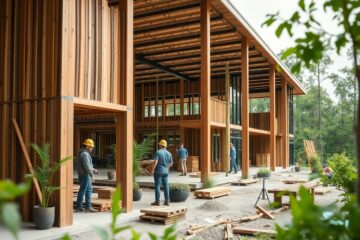Exploring the complexities of radioactive building materials is crucial in comprehending the potential risks associated with them. From radon gas seeping through foundations to uranium-containing concrete, these materials can present serious health hazards if not properly understood and managed.
By delving into the science behind the radiation emitted from these materials, we can better grasp the extent of the potential dangers they pose to individuals and the environment. Let’s uncover the hidden risks lurking within our built environment and gain a deeper understanding of how to mitigate them effectively.
Table of Contents
The Nature of Radioactivity
A fundamental understanding of radioactivity is crucial in comprehending the potential risks associated with radioactive building materials. Radioactivity is a natural phenomenon in which unstable atomic nuclei lose energy by emitting ionizing radiation, which can take the form of particles or electromagnetic waves.
What is Radioactivity?
With radioactivity, atoms undergo spontaneous disintegration, transforming into different atoms and emitting energy in the process. This emission of energy is what we refer to as radiation, and the materials that exhibit this phenomenon are said to be radioactive.
Radioactivity is measured in units known as becquerels (Bq), which quantify the rate of radioactive decay in a sample. Understanding the nature of radioactivity involves recognizing the three primary types of radiation: alpha, beta, and gamma.
The Different Types of Radiation
Alpha radiation consists of positively charged alpha particles, which are relatively large and can be stopped by a sheet of paper or human skin. Beta radiation involves fast-moving electrons or positrons that can penetrate deeper into materials, such as wood or plastic.
Gamma radiation is high-energy electromagnetic radiation that can penetrate most materials, making it the most difficult to shield against. Neutron radiation, although less common, can also pose risks due to its ability to interact with nuclei and induce transmutation.
| Alpha Radiation | Beta Radiation |
|---|---|
| Positively charged particles | Fast-moving electrons or positrons |
| Stopped by paper or skin | Penetrate materials like wood or plastic |
| Low penetration power | Medium penetration power |
| Originates from atomic nuclei | Originates from decay of atomic nuclei |
| Least harmful externally | Can damage living tissue |
Different materials emit different types of radiation depending on their atomic structure and stability. Understanding the characteristics of each type of radiation is essential in assessing the potential risks associated with radioactive substances.
- Alpha radiation consists of alpha particles and has low penetration power.
- Beta radiation involves electrons or positrons and can penetrate materials like wood or plastic.
- Gamma radiation is high-energy electromagnetic radiation with high penetration power.
- Neutron radiation can interact with nuclei and induce transmutation.
- This knowledge is crucial in determining appropriate safety measures when dealing with radioactive materials.
Radioactive Elements Commonly Found in Building Materials
Some building materials contain radioactive elements that can pose health risks if not properly managed. Understanding the types of radioactive materials commonly found in construction can help mitigate potential hazards and ensure safety.
Naturally Occurring Radioactive Materials (NORM)
Materials such as granite, concrete, and certain types of soil contain naturally occurring radioactive elements like uranium, thorium, and potassium-40. These materials emit low levels of radiation that are typically not harmful to human health in normal conditions. However, prolonged exposure to high concentrations of NORM can increase the risk of radiation-related health effects.
It is essential for builders, contractors, and homeowners to be aware of the presence of NORM in building materials and take appropriate precautions to minimize exposure. Testing for radiation levels and implementing proper ventilation and shielding measures can help reduce the potential health risks associated with NORM.
Technologically Enhanced Naturally Occurring Radioactive Materials (TENORM)
Radioactive elements can also be technologically enhanced in certain building materials through processes like mining, extraction, and manufacturing. Materials like ceramic tiles, phosphogypsum, and certain metals may contain elevated levels of radioactive isotopes due to human activities.
It is important to note that TENORM can pose a higher risk of radiation exposure compared to NORM, especially when these materials are broken down or disturbed during renovation or demolition. Careful handling, disposal, and monitoring of TENORM-containing materials are crucial to prevent unnecessary exposure to radiation.
Sources of Radioactive Materials in Buildings
Now, let’s delve into the sources of radioactive materials that can be found in buildings. Understanding where these substances come from is crucial in assessing the potential risks they pose and how to mitigate them.
The Historical Use of Radioactive Elements in Construction
Construction materials containing radioactive elements have been used for various purposes in the past. One notable example is the use of radium in the early 20th century to create glow-in-the-dark paint for watch dials. This practice exposed many workers to harmful levels of radiation and led to health complications, demonstrating the dangers of using radioactive materials without proper precautions.
Another historical source of radioactive materials in buildings is the use of uranium in certain types of glass and ceramic tiles. While these materials were popular for their decorative properties, they also introduced a potential health hazard due to their radioactive nature.
Modern Building Materials that Contain Radioactive Components
Radioactive elements can still be found in modern building materials, albeit in smaller quantities than in the past. Materials such as granite, marble, and certain types of concrete may contain radioactive isotopes like radium, thorium, and potassium-40. These elements can emit radiation and contribute to the overall radioactivity of a building.
For instance, granite countertops have gained popularity in recent years due to their durability and aesthetic appeal. However, some granites can contain higher levels of radioactive elements, posing a potential health risk if not properly managed. It’s important for homeowners and builders to be aware of the radioactive components in building materials and take appropriate measures to ensure safety.
Health Risks Associated with Radioactive Building Materials
After understanding the science behind radioactive building materials, it’s crucial to delve into the health risks associated with these materials. Radioactive building materials can pose serious health hazards if not properly managed and handled.
Understanding the Exposure Pathways
Any exposure to radioactive building materials can occur through various pathways. Inhalation of radioactive particles released from these materials is one of the primary pathways. Additionally, direct contact with contaminated surfaces and ingestion of radioactive substances can also lead to exposure.
Exposure to radioactive building materials can result in a range of health effects, depending on the type and amount of radiation involved. Acute effects, such as radiation burns and radiation sickness, can occur immediately after exposure. Chronic effects, such as an increased risk of cancer and genetic mutations, may manifest over a longer period of time.
Long-Term Health Effects of Radiation Exposure
One of the most concerning long-term health effects of radiation exposure is the increased risk of developing cancer. Prolonged exposure to low levels of radiation from radioactive building materials can lead to the development of various types of cancer, including leukemia and solid tumors.
Health studies have shown that exposure to radiation can also affect reproductive health, leading to an increased risk of birth defects and reproductive abnormalities in future generations. It’s crucial to mitigate exposure to radioactive building materials to prevent these long-term health effects.
Health risks associated with radioactive building materials can have severe consequences on individuals’ well-being, including an increased risk of cancer and reproductive abnormalities.
Measuring and Assessing Radioactive Risk in Buildings
Keep in mind that the assessment and measurement of radioactive risk in buildings is crucial for ensuring the safety of occupants and workers. Understanding the tools, techniques, standards, and thresholds used in this process is essential for effectively managing potential radioactive hazards.
Tools and Techniques for Radioactive Measurement
Tools and techniques for measuring radioactivity in buildings include: Geiger counters, gamma spectrometers, and radon detectors. Geiger counters are portable devices that detect ionizing radiation, while gamma spectrometers provide detailed information on the energy levels of gamma radiation. Radon detectors are specifically designed to measure radon gas levels, a common radioactive hazard found in buildings. These tools are essential for identifying and quantifying radioactive sources within a building, allowing for proper risk assessment.
Standards and Thresholds for Safe Radiation Levels in Buildings
Standards and thresholds for safe radiation levels in buildings are established by regulatory bodies such as the Environmental Protection Agency (EPA) and the International Commission on Radiological Protection (ICRP). These standards dictate the maximum permissible levels of radiation exposure for occupants and workers in buildings to ensure their safety. It is important to adhere to these guidelines to minimize the risk of harmful health effects associated with radiation exposure.
Techniques such as air sampling, surface contamination measurements, and radiation surveys are commonly employed to assess radiation levels in buildings. Air sampling helps detect airborne radioactive particles, while surface contamination measurements identify radioactive materials on surfaces. Radiation surveys involve systematic measurements of radiation levels in different areas of a building to map out potential hotspots. This comprehensive approach allows for a thorough assessment of the radioactive risk present in a building.
Mitigation and Remediation Strategies
Best Practices for Mitigating Radiation Exposure in Existing Buildings
To minimize radiation exposure in existing buildings, it is crucial to conduct thorough assessments to identify sources of radioactive materials. Regular monitoring and testing of building materials can help detect any signs of radiation leakage or contamination. Implementing proper ventilation systems and sealing off areas with high levels of radiation are effective ways to prevent the spread of radioactive particles.
The use of shielding materials such as lead or concrete can also help reduce radiation levels in buildings. Additionally, training staff on radiation safety protocols and providing protective gear are essential steps in mitigating radiation exposure and ensuring the safety of occupants.
Guidelines for Disposal and Recycling of Radioactive Building Materials
Remediation strategies for disposing and recycling radioactive building materials involve strict adherence to regulations set forth by relevant authorities. Proper containment and secure storage of radioactive materials are crucial to prevent environmental contamination and potential health risks. Labeling and tracking radioactive waste throughout the disposal and recycling process is fundamental to ensure proper handling.
Plus, employing licensed professionals with expertise in radioactive material management is vital to guarantee compliance with disposal guidelines and mitigate any potential hazards associated with the handling of radioactive building materials.
Policy and Regulatory Framework
Not understanding the policy and regulatory framework surrounding radioactive building materials can lead to serious consequences. It is crucial to have a comprehensive understanding of the guidelines and regulations in place to mitigate risks associated with these materials.
International Guidelines and Regulations for Radioactive Building Materials
Radioactive building materials are governed by a set of international guidelines and regulations to ensure global safety standards. Organizations such as the International Atomic Energy Agency (IAEA) and the United Nations Scientific Committee on the Effects of Atomic Radiation (UNSCEAR) play a crucial role in establishing these regulations.
These guidelines focus on monitoring, controlling, and regulating the use of radioactive building materials to prevent potential health hazards. By adhering to these international standards, countries can minimize the risk posed by these materials and protect public health and safety.
National and Local Regulations – A Comparative Analysis
Radioactive building materials are also subject to national and local regulations, which can vary significantly from country to country. It is essential to conduct a comparative analysis of these regulations to understand the differences in safety protocols and enforcement measures.
| National Regulations | Local Regulations |
| National regulations set overarching standards for the use of radioactive building materials nationwide. | Local regulations may address specific concerns or conditions related to the use of these materials within a particular jurisdiction. |
| Enforcement of national regulations is typically overseen by government agencies at the federal level. | Local regulations are enforced by municipal or regional authorities responsible for building codes and safety standards. |
The comparative analysis of national and local regulations provides valuable insights into the diverse approaches taken to manage radioactive building materials at different administrative levels. This analysis enables policymakers and stakeholders to identify areas of improvement and harmonize regulations for enhanced safety and compliance.
Framework
| Key Details | Impact |
| The regulatory framework ensures comprehensive oversight of radioactive building materials. | Important: Helps prevent health risks and environmental contamination. |
| Collaboration between international, national, and local entities strengthens regulatory compliance. | Positive: Promotes consistency and ensures effective implementation of safety measures. |
To wrap up
So, understanding the science behind the risk of radioactive building materials is crucial for ensuring the safety of our communities. By breaking down the complex nature of radioactivity and how it interacts with the environment, we can better assess and manage the potential dangers posed by these materials. It is essential for policymakers, engineers, and the public to work together to implement rigorous protocols for handling radioactive building materials to minimize the risk of exposure and contamination.
FAQ
Q: What are radioactive building materials?
A: Radioactive building materials are construction materials that contain naturally occurring radioactive elements like radium, thorium, and uranium. These elements can emit radiation which poses health risks if not properly managed.
Q: How are people exposed to radiation from these materials?
A: People can be exposed to radiation from radioactive building materials through inhalation of radioactive dust, ingestion of contaminated food or water, and direct exposure to gamma radiation emitted by the materials.
Q: What are the health risks associated with exposure to radioactive building materials?
A: Health risks from exposure to radioactive building materials include increased risk of cancer, genetic mutations, and other radiation-related illnesses. Prolonged exposure to these materials can have serious long-term effects on health.
Q: How can the risk from radioactive building materials be mitigated?
A: The risk from radioactive building materials can be mitigated through proper assessment and identification of sources, implementing containment measures, and conducting regular monitoring and maintenance to ensure safe levels of radiation.
Q: Who is responsible for managing the risks from radioactive building materials?
A: Building owners, construction companies, and regulatory authorities are responsible for managing the risks from radioactive building materials. It is important for all stakeholders to work together to ensure the safety of occupants and the public.

Our contributing author is a passionate advocate for eco-friendly living and sustainability. With a background in eco-life, they are dedicated to inspiring and empowering individuals to adopt environmentally conscious lifestyles. Through insightful articles, they share practical tips, innovative solutions, and thought-provoking perspectives to promote a greener, more sustainable world. Join them on the journey towards eco-smart living and discover how small choices can make a big impact. 🌱









